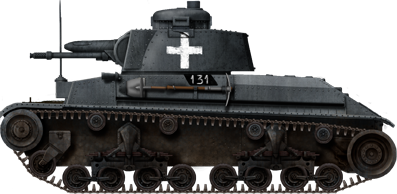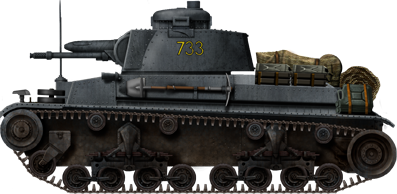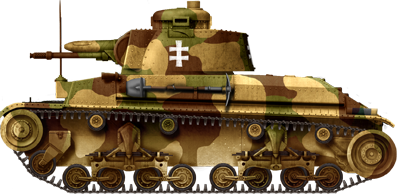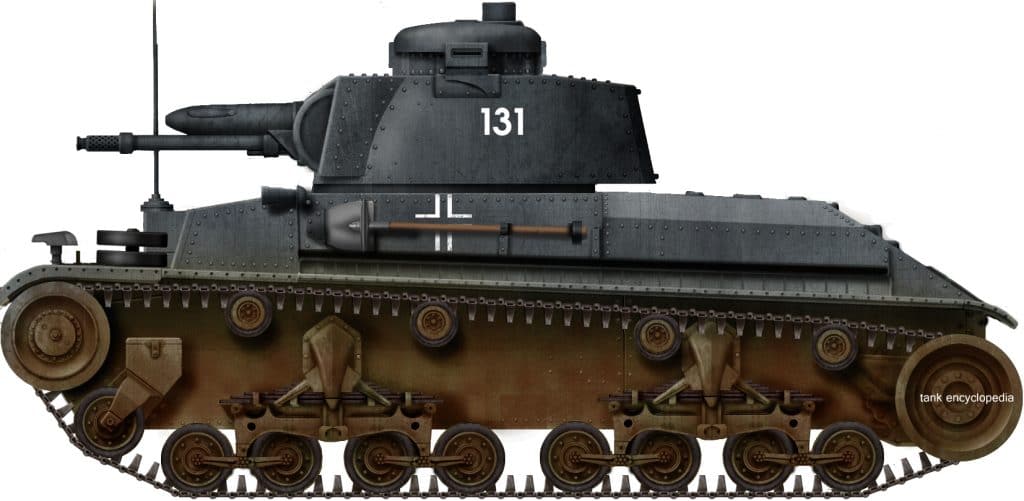 German Reich (1940)
German Reich (1940)
Light Tank – 244 Operated
One year after the Anschluss (the annexation of Austria by Nazi Germany) in March 1938, Adolf Hitler implemented the occupation of the Sudetenland (Bohemia-Moravia) and the seizure of Czechoslovakia.
As a result, the Germans took over the Czechoslovak industry, including the Skoda factory, which produced the Lehký tank vzor 35 (Light Tank Model 35), locally known as the LT vz. 35, or LT-35. By the time of the German occupation, Czechoslovakia had built 434 LT vz. 35 light tanks. The Germans immediately took over 244 of them in order to equip their emerging armored forces.
These light tanks fought in the German Panzer Divisions from 1939 until 1942, when they were removed from active service. During this three-year period, they actively participated in the Invasion of Poland, the Battle of France and the initial stages of Operation Barbarossa (the ill-fated and costly invasion of the Soviet Union).
The tanks were highly praised by their crews, especially their robustness (except the pneumatic system, which was very susceptible to extreme cold) and versatility. They were used until the exhaustion of the spare parts available for this model. When in use with the Germans, it was known as Panzerkampfwagen 35(t) or Pz.Kpfw.35(t). The letter “t” indicated the term ‘Tschechisch’ (meaning ‘Czech’ in German), following the rule of using a letter designating the name of the country of origin for the material captured by the Germans.

Pz 35(t) and Panzer IVs in France, 1940. Photo: Bundesarchiv
LT vz. 35, the Original
The Lehký tank vzor 35 (Light Tank Model 35, LT vz. 35) was the frontline tank of Czech armored forces at the time of the German invasion. The 10.5-ton tank entered service in 1939. It had a 3-man crew and was armed with a 37mm Škoda ÚV vz.34 gun, with two 7.92 mm (0.31 in) Zbrojovka Brno vz.37 machineguns. The tank had armor of up to 35 mm (1.4in) thick.
The vehice ran on a leaf-spring suspension, and propulsion was provided by a 120hp Škoda Typ 11/0 4-cylinder gasoline engine. This would provide a top speed of 21 mph (34 km/h).
A full article on the LT vz. 35 can be found HERE.
Pz.Kpfw.35(t), German Service
At the beginning of WWII, the Germans had shocked the world with their combined arms tactics. Armored forces were essential in the practical application of this doctrine, with armored vehicles paving the way for the infantry. There was a pressing need for quick, well-armed armored vehicles. In April 1939, the Germans had in their inventory about 230 Panzer III tanks. The LT vz.35 was classed similarly in the German army and with the confiscation of these 244 Czech tanks, their medium-light armored forces more than doubled.
The Germans used everything available to them, from new vehicles coming out of assembly plants to old veterans of the Czech conflicts in the Sudetenland. Most of these vehicles were sent to the 11th Panzer Regiment in Paderborn and the 65th Panzer Abteilung in Sennelagen. They used the Pz.Kpfw.35(t) to the limit of its useful life, as production had already been completed by the Czech factories. The Germans did not think to resume their manufacture because the pneumatic system of these tanks was problematic for maintenance.
Design
Many of the elements of the basic design of the Czech vehicle remained the same. In the name of the standardization, the Germans made many modifications in the Czech LT vz. 35. The most evident was the painting of all vehicles in the standard German-Gray color, with a large white cross, preceding the infamous Balkenkreuz, applied to the side of the turrets. Some tanks had stripes of brown or green on the German-gray, but this was not common.
The big white crosses were gradually removed shortly after the first stages of the Invasion of France, as the enemy gunners used them as excellent aiming points. Many vehicles were penetrated in this way in Poland and France. At the time of the Invasion of Russia, the great majority of Pz.Kpfw.35(t) tanks had much smaller and discrete Balkenkreuz on the sides of the hulls.
In mechanical terms, the main modifications were the installation of German radios and intercoms, the installation of Notek lights on the left front mudguards and German lights on the rear of the tanks. Another important modification was the replacement of Czech magnets with Bosch ones, made in Germany. To increase the range of the vehicles, extra fuel was carried in jerry-cans installed in racks at the rear of the hull.
But the most important of all modifications were based on tactical studies of the use of the armored vehicles: the incorporation of a fourth crewmember. This fourth crewmember was a loader and his addition was meant to reduce the commander’s workload and to increase the efficiency of the vehicle and of its crew. With the presence of the loader, the commander could concentrate on observing the tactical situation of the battle in which he was involved, increasing his effectiveness and greatly increasing the ability of the tank to accomplish its tasks and survive.

Operation Barbarossa 1941: North sector, 1941, German Infantry supported by a Panzer 35(t) – Bundesarchiv
The effectiveness of this decision was well proven in the brief but intense Battle of France when the German Panzers (with their 3 turret members: gunner, loader, and the commander) faced the French tanks, whose turrets were only crewed by the commander. The French commanders had to load, aim, shoot and even discern the whole tactical environment of the battle. The cost of this modification was a decrease in the number of projectiles stored in the tank turret.
The Germans also modified some of the Pz.Kpfw.35(t)s into the Panzerbefehlswagen 35(t), or command tanks. The transformation was intended to increase the internal space of the tank to facilitate the control tasks. This was achieved by eliminating the front hull machine gun and installing an additional Fu 8 radio and a gyrocompass. The major external differential factor of these command vehicles was the presence of a large frame antenna on the rear deck just behind the turret.

Panzer 35(t) of the 11th Tank Regiment, 1st Light Division of the Wehrmacht. Poland, September 1939.

Panzer 35(t) of the 65th Panzer battalion, 11th Panzer Regiment, 6th Panzer Division. Eastern Front, Summer 1941.

The original LT vz. 35 in Czech service.
Illustrations by Tank Encyclopedia’s own David Bocquelet
Operational Use
With tensions in Europe growing and the possibility of war increasingly close, the German crews trained intensively with their new tanks alongside the maintenance and logistics personnel. The planned invasion of Poland was imminent.
By the end of August, the 11th Panzer Regiment had its companies fully equipped with the light Pz.Kpfw.35(t), with additional tanks in reserve. The 11th Panzer Regiment formed a part of the 1st Leichte Division. For the Fall Weiss Operation (the invasion of Poland), 106 Pz.Kpfw.35(t) and eight Panzerbefehlswagen 35(t) were ready for combat.
Proving its robustness and reliability, many Panzer 35(t) tanks covered more than 600 km on their own tracks, on very rough roads or in open field, with no major breakdowns (the fragility of the pneumatic system only manifested itself in very low temperatures). They participated in the hard battles at Wielun on September 3 and at Widawa, Radom and Demblin, on September 9. The Pz.Kpfw 35(t)’s ended their participation in the Polish Campaign between the 17th and the 24th of September in the north of Warsaw at Mandlin.
The armor of the Pz.Kpfw 35(t) could easily manage artillery shrapnel, machine gun bullets and infantry anti-tank rifle rounds. It could also withstand 20mm cannon fire, but the 37mm anti-tank shells of the wz.36 AT gun and 7TP light tanks could penetrate the 25mm armor. At the end of the Polish Campaign, 11 tanks were heavily damaged, but almost all were refurbished by Skoda to return to the front line. Only one was considered a total loss.
It was observed that the tanks moved by their own means for far greater distances than expected, thanks mainly to the reliability of the machines. With the lull coming after the fall of Poland, the armored forces installed reserve track links and supplementary rubber tires for their suspension wheels. Another measure was the installation of a rack for jerry-cans with extra fuel.
After the end of their first combat action came a period of tension and reorganization for the German Armored Forces. The 1st Leichte Division was renamed as the 6th Panzer Division, with its 118 Pz.Kpfw.35(t) restored survivors and its 10 Pz.Bef 35(t), serving with the 11th Panzer Regiment.
During the ensuing invasion of France, the 6th Panzer Division reported 45 casualties among its Pz.Kpfw.35(t), but only 11 were considered total losses. The other 34 returned to active service after being retrieved from the battlefield and repaired by the workshops in Germany and Czechoslovakia. Many of these casualties were due to the exhaustive use.
The Pz.Kpfw.35(t)s remained as first-line vehicles until the beginning of 1941. The 6th Panzer Division still listed in its inventory 149 Pz.Kpfw.35(t) gun tanks and 11 Pz.Bef.35(t) command tanks at the end of June 1941, being used for Operation Barbarossa. Because of the long distances in this theater of operations, the Pz.Kpfw.35(t) carried up to 8 jerry-cans in additional fuel racks on the rear portion of their hulls, in addition to a greater load of spare parts.
In battle, the Pz.Kpfw.35(t)’s were still effective against the Soviet light tanks, but when meeting the T-34, KV-1 and KV-2, it became painfully clear that the small and reliable 37mm main guns could do nothing against the armor of these tanks. But even so, the Germans continued to use these tanks. It can be said that the removal of the Pz.Kpfw 35(t) from the front lines of combat was due more to the mechanical wear (these vehicles had covered enormous distances in Poland, France and Russia) and the climatic conditions (The Russian winter was too much for the fragile hydraulic and pneumatic lines of the tank). On the 30th of November 1941, all Pz.Kpfw. 35(t)s were reported as “non-operational” on the Russian front.
All surviving vehicles were sent back to Germany and Czechoslovakia, where some less worn out were remanufactured for other uses. Forty-nine of these vehicles had their turrets and armament removed. A tow- bar with a capacity of 12 tonnes was installed in the back of the hull, along with more jerry-cans for extra fuel. These vehicles, converted by Skoda, once again served Germany as artillery tractors and ammunition carriers: Morserzug-Mittel 35(t). Rather than waste the turrets, these were reused as fortified bunkers and fixed fortifications on the shores of Denmark and Corsica.
Panzer 35(t) specifications |
|
| Dimensions | 4.90×2.06×2.37 m (16.1×6.8ftx7.84 ft) |
| Total weight, battle ready | up to 10.5 tons |
| Crew | 4 (commander, driver, gunner, loader/radio) |
| Propulsion | Škoda Typ 11/0 4-cylinder gasoline, 120 bhp (89 kW) |
| Speed (on/off road) | 34 km/h (21 mph) |
| Suspension | Leaf spring type |
| Armament | Main: Škoda ÚV vz.34 37 mm (1.46 in), 72 rounds Secondary: 2 x 7.92 mm (0.31 in) Zbrojovka Brno vz.37 machineguns, 1800 rounds |
| Armor | 8 to 35 mm (0.3-1.4in) |
| Maximum range on/off road | 120/190 km (75/120 mi) |
| Total production | 434 |
Links, Resources & Further Reading
Skoda LT vz.35 – Vladimir Francev and Charles k. Kliment – MBI Publishing House; Praha – Czech Republik
Panzerserra Bunker


12 replies on “Panzerkampfwagen 35(t)”
Hi there,
in the text about the Panzerkampfwagen 35(t) you use the word “Balkan Cross”, but if you want to write it as the Germans, it is corrrect “Balken-Kreuz”.
The “Balken” is similar to the english “beam”
It has been amended, thank you.
– TE Moderator
733 is imaginationary panzer. Pz abt 65(III/Pz rgt 11) used 35t’s in its 1. and 3.kompanies. On other hand II/Pz rgt 11 had 35 t’s in its 7.K, but turret numbers were white and smaller. They also had big storagebox on left fender. Also all kompanies had 5jerrycans on reardeck in place of trapaulinroll.
I know this is way out of the time period and topic, but I seemed to have found some sort of documments of the 90mm Gun Tank T49. They seem pretty legit, and I think they may seem to prove of use. If you want their link, i may as well put it here, unless you’ve looked at it before. So, uhh, yeah.. Good job on this tank page though!
As always, a nice *cold and snowy now* hello from Canada.
General Soldiernator
We finally got some snow over here in Eastern Canada a few days ago, im pretty sure.
i found this very useful
I’ve been posting URLs to some of your entries to a Facebook group in which I’m an admin. It’s a closed group of 17000 members and growing. The group is: International Military Model World. I hope you don’t mind.
Not at all. please continue to do so. We appreciate the publicity.
– TE Moderator
Did the Germans do a conversion of the 35(t) to a panzerjager mounting the Cezch 47mm? I have a 1/72 scale model of one but can’t find any reference to it.
To my knowledge the Germans didn’t produce any tank destroyers on the 35(t) chassis. The Romanians did make the TACAM R-2 with a 76mm gun on the 35(t) (or R-2 in Romanian service) chassis though
TE Moderator
Found this unverified article. http://ftr.wot-news.com/2014/12/31/panzerjager-auf-35t/
Škoda repair logs.
One interesting thing that popped up in them (if I remember correctly) was a record of two vehicles repaired in 1941 (after the Soviet Union invasion). They were German-made field conversions of the (by now obsolete) Panzer 35t (Czechoslovak LT Vz.35). The Germans removed the turret and added some sort of superstructure along with the 47mm Czechoslovak AT gun, used in the well-known Panzerjäger I. Unfortunately, no photo or description of these vehicles survived
“in the north of Warsaw at Mandlin.” It should be Modlin, not Mandolin.